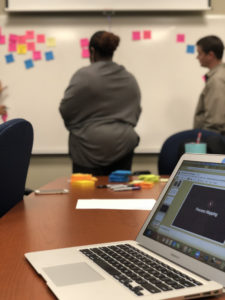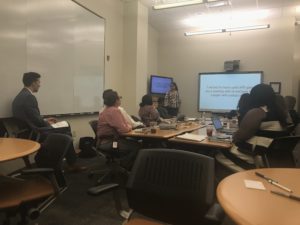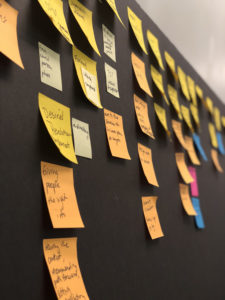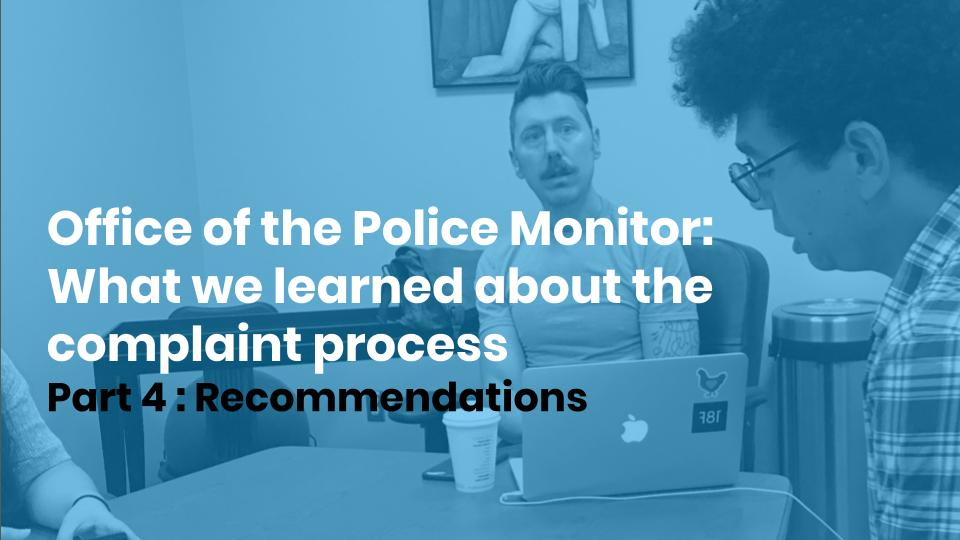Part 4: Recommendations
Over 2018, Austin Tech Alliance, in collaboration with the City of Austin’s Communication & Technology Management department partnered with several City of Austin offices to identify smart initiatives that will solve local challenges and improve City services. We wrapped up working with the Office of the Police Monitor in October. During this project we worked as a cohesive team to understand the current pain points and obstacles residents face when submitting complaints about their experience with the Austin Police Department.
In Part 3 of this series we learned about the research themes that were discovered after conducting research with the department and the community. Let’s dive into our recommendations.
 Public’s Experience with the Austin Police Department
Public’s Experience with the Austin Police Department
Change the Office of Police Monitor’s name to the Independent Office of Police Accountability.
- Mitigates fear of things “getting back to APD” by showing immediately that the Office is independent, represents the public, not only citizens.
- Puts Police Department’s goal to have a more accountable, trusting relationship with the community front and center.
Asking for Feedback & Discovering/Submitting Form
Send a simple feedback poll to collect public feedback every time they have a police interaction
- Shows Austin Police Department cares about public feedback, pushes members of the public who’ve had good or bad experiences immediately to the Office of Police Monitor website
- Already underway by Austin Police Department
Make the complaint/feedback process as accessible as possible by making intake available online, or via phone/in person with community locations where members of the public are already comfortable
- This takes advantage of trusted community relationships that already exist, doesn’t force community leaders who are weary of “betraying” their constituent’s trust by referring them to the complaint process to turn over feedback
- In short: You can complain anywhere. From your home on the phone/online, or where you feel comfortable, with whom you feel comfortable, and you can be assured a certain level of customer experience and counsel whichever method you choose
Set expectations, demystify the process, a decision tree tool/quiz that matches public expectations, needs, and fears, to the options available.
- This sets expectations early on about what the potential outcomes of a category of complaint could be, and proactively respond to public preferences including their fears and time commitment
Remove the three kinds of complaints. Have one online complaint form that captures what’s important in all complaint processes.
 Get rid of the affidavit, make everything except the narrative of the complaint optional.
Get rid of the affidavit, make everything except the narrative of the complaint optional.
- Makes option to talk to a supervisor about a complaint a check-box. So that no matter what the complaint has the potential to lead to discipline, but could also be mediated through the conversation
- Available in different languages, with checkbox option to ask for a translator in your language (including sign language, and not just American) in all future interactions
Set expectations, demystify the process, a “pizza-tracker” and confirmation number received upon submission that allows the public to see what stage in the process your complaint/feedback is at, and how long it will take at each stage
- Members of the public can call with their confirmation number, which on the back end is their case number.
- The stages of the process are in plain language and explanatory, while not giving away the particulars of the individual case. So the member of the public gets some transparency without compromising confidentiality.
Follow up, interview, & checking-In
Interviews are scheduled using a tool that considers everyone’s schedule, questions are determined collaboratively in advance at a consensus meeting.
- Avoids last minute scheduling of interviews, complaint specialists not being prepared for an interview with all the materials necessary in advance
- Gets around some of the tension with Office of Police Monitor specialists needing to ask their questions via a sergeant to officers
 Office of Police Monitor is the touchpoint between the public and the investigation process. Internal Affairs Sergeants don’t call members of the public directly.
Office of Police Monitor is the touchpoint between the public and the investigation process. Internal Affairs Sergeants don’t call members of the public directly.
- Office of Police Monitor calls to schedule interviews with a complainant or witness (any civilian), sets expectations
- Reduces intimidation factor. It feels like you’re in trouble when you get a call from the police.
Investigation interviews can happen in accessible locations where members of the public are most comfortable, and likely not at Office of Police Monitor/Internal Affairs building.
- When Office of Police Monitor calls to schedule an interview, they offer to come to the public where they’re comfortable:
- Library conference rooms
- Community centers
- Community organizations
- Homes
- Maybe there are confidentiality requirements for the location (i.e. needs to be quiet, where others won’t overhear etc.)
- Bring a translator if they opted in, and make sure locations are accessible
- Ask whether they prefer or are more comfortable being interviewed by a particular gender
Close-Out
Once a case is closed, complainant receives an email letter reviewing the content of their complaint, mapping that content to relevant policies, specifying whether any violations were found, providing the classification of the complaint, and bringing back the decision matrix to show what the possible outcomes were (assuming it wasn’t a suspension and you couldn’t point to a disciplinary memo)
- Improves transparency without compromising confidentiality
- Any relevant recommendations by the Police Monitor and responses by the Chief would be public upon closing the case, and the complainant would be pointed to these in the letter
Complainant has the opportunity to attend a close out meeting with the Police Monitor, a complaint specialist, an Internal Affairs officer out of uniform, and potentially a translator to explain the process and outcome.
- There are strict parameters established for what can and can’t be discussed at these meetings
- Meetings can again take place anywhere where the complainant is comfortable and meets confidentiality requirements
- When Office of Police Monitor calls to schedule the meeting, they set expectations about what can and can’t be discussed
After the close out meeting, the complainant receives a feedback survey asking about their experience with the complaint process.
- Complainant feels heard, and like they have the opportunity to improve the process
- Office of Police Monitor and Internal Affairs get valuable data on how complainants feel, and what parts of the process need to be tweaked
 Pattern-finding and trust building
Pattern-finding and trust building
There is a public Police Accountability Open Data Portal that contains Austin Police Department data, Office of Police Monitor complaint data, community data, other city oversight data, and other relevant national, community data sets that might be useful.
- Members of the public and organizations can pull data directly, and use interactive front end visuals to explore different data sets
- Office of Police Monitor can use the complaint data (if it’s only limited to that) to generate trend reports and annual reports
- Other organizations can use all the data to push for necessary policies
Cohesive cycle of pattern finding, recommending, educating, and publicizing with new full time employees
Office of Police Monitor Research Analysts, data analyst interns comb through the open data portal regularly looking for trends, and regularly generate numbers on trends of interest.
- For example, providing monthly reports on racial profiling, generating maps on police presence overlaid with race, income, etc.
- This data informs Office of Police Monitor’s regular reporting
Office of Police Monitor Policy Analysts take the data generated and cross reference it with national best practices to write policy recommendations, both in the form of memos for the chief, and in the form of reports, infographics etc. for the public.
- The Police Monitor compiles these memos at appropriate times and brings them to the Chain of Command, and community partners for review.
Office of Police Monitor generates different forms and frequencies of reports using data and policy recommendations.
- For example, Office of Police Monitor might release a weekly data visualization tweet on use of force by ZIP code, monthly flash trend infographics with data around a specific trend they’ve noticed, a quarterly report and presentation of all their recommendations to community organizations and chain of command, and an annual report that focuses on evaluating the impact of Office of Police Monitor’s activities that year compared to other city oversight agencies.
To learn more about all ATA’s programs visit our Programs page and follow us on twitter.

